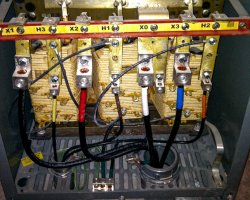-
Welcome to The Building Code Forum
Your premier resource for building code knowledge.
This forum remains free to the public thanks to the generous support of our Sawhorse Members and Corporate Sponsors. Their contributions help keep this community thriving and accessible.
Want enhanced access to expert discussions and exclusive features? Learn more about the benefits here.
Ready to upgrade? Log in and upgrade now.
You are using an out of date browser. It may not display this or other websites correctly.
You should upgrade or use an alternative browser.
You should upgrade or use an alternative browser.
Transformer bonding and the first means of disconnect
- Thread starter jar546
- Start date
jar546
CBO
No one does electrical inspections?
Is there a secondary neutral? GECs and EGCs should not be routed through lay-in lugs on bushings.
This kind of stuff is above my level of expertise. I have inspected maybe five transformers in twenty-five years. The covers were still on and the vibration noise had me convinced that the transport springs were removed. Nothing blew up and I didn’t see any blood stains. Let me be the first to state that I had no business doing the inspection… there I beat you to the punch.
So with your picture I can just take a shot in the dark. I see phases with a neutral coming in but not going out. While that seems odd ... who knows, it could be as normal as carp in the Rock River. Maybe I’ve got it all wrong and it’s a step up with no neutral coming in.
Your question is about tying the neutral and ground at the secondary disconnect. Hard to know without exploring the NEC. If the primary has a bonded neutral and the secondary shares the neutral I’m leery of a secondary bonded neutral. But hey now I can be all over the map with this because it will never be in my wheel house.
I could delve into the NEC and find an answer… or you could take the step to educate us. I for one, would be happy to learn from you.
This kind of stuff is above my level of expertise. I have inspected maybe five transformers in twenty-five years. The covers were still on and the vibration noise had me convinced that the transport springs were removed. Nothing blew up and I didn’t see any blood stains. Let me be the first to state that I had no business doing the inspection… there I beat you to the punch.
So with your picture I can just take a shot in the dark. I see phases with a neutral coming in but not going out. While that seems odd ... who knows, it could be as normal as carp in the Rock River. Maybe I’ve got it all wrong and it’s a step up with no neutral coming in.
Your question is about tying the neutral and ground at the secondary disconnect. Hard to know without exploring the NEC. If the primary has a bonded neutral and the secondary shares the neutral I’m leery of a secondary bonded neutral. But hey now I can be all over the map with this because it will never be in my wheel house.
I could delve into the NEC and find an answer… or you could take the step to educate us. I for one, would be happy to learn from you.
Last edited:
jar546
CBO
The picture answers the original question.Is there a secondary neutral? GECs and bonding jumpers should not be routed through lay-in lugs on bushings
chris kennedy
ADMIN
EGC bonded to neutral in secondary disconnect. Notice anything odd about the GEC?
steveray
SAWHORSE
I thought there was something about attaching the grounding over the slots in the bottom, but took a quick look and couldn't find it....Hate that book...Looks like it is cut/ broken...
EGC bonded to neutral in secondary disconnect. Notice anything odd about the GEC?
jar546
CBO
Oh, and in addition to the question in the OP, there are some issues too. What are they.
wwhitney
REGISTERED
Why not? Seems perfectly normal to me. If a GEC is contained in a metal conduit, it needs to be bonded to the metal conduit at both ends, and running it through a grounding bushing would be one way to do that. And EGCs and bonding jumpers get connected to metal conduit all the time, with a grounding bushing being one way to do it.GECs and EGCs should not be routed through lay-in lugs on bushings.
Cheers, Wayne
The resulting sharp bends. If enough current hits the bend, it will blow out.Why not?
250.4(A)(1) Electrical System Grounding.
Electrical systems that are grounded shall be connected to earth in a manner that will limit the voltage imposed by lightning, line surges, or unintentional contact with higher-voltage lines and that will stabilize the voltage to earth during normal operation.
Informational Note No.1: An important consideration for limiting the imposed voltage is the routing of bonding and grounding electrode conductors so that they are not any longer than necessary to complete the connection with out disturbing the permanent parts of the installation and so that unnecessary bends and loops are avoided.
Last edited:

